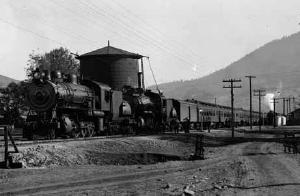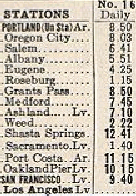The Siskiyou line - past and present.
Until 1926, the Siskiyou line was a trunk route for both freight and passenger traffic. Southern Pacific advertised its beauty and great sights, but never advertised its speed. There were two reasons: The Siskiyou Pass and Cow Creek Canyon. The latter is a waterlevel route, that has the same kind of curvature as the Sacramento River Canyon.
Main reason for low speed was the Siskiyou Pass itself. For 81 miles between Weed and Ashland, the trains needed four to five hours, due to steep grade, the need for helper attachment, and the unbelievably heavy cars of those times. For a given length, they were three times as heavy as Talgo cars.


Train No. 16 in Hornbrook. Timetable of Train No. 16 in 1927.
Several passenger trains were rerouted via the Natron Cutoff in spring 1927. At first, there was still through traffic via the Siskiyou route, but on the new Highway 99, even buses were faster than those heavy, slow trains. More and more cuts reduced the remaining traffic. One pair of nighttrains to and from Portland had survived in the 1950s, operating north of Ashland only. Last day of regular passenger train operation on the Siskiyou Line was August 6th, 1955. The sawmills made sure, that it was still an important source of railfreight. But Southern Pacific lost all interest, when the output of the timber industry declined..
Today, the shortline "Central Oregon & Pacific (CORP)" owns the northern part of the line from Eugene to Bellevue near Ashland. The southern part is owned by Union Pacific, and leased to CORP, which operates on the whole Siskiyou Line. On average, traffic is less than 100 carloads per day, of which only a minor share has to cross the Siskiyou Pass.